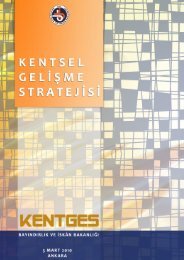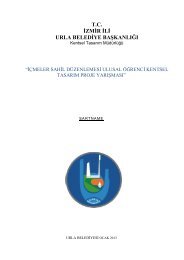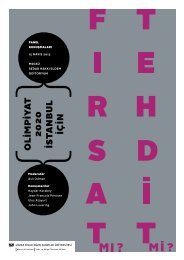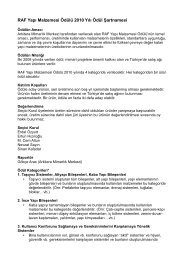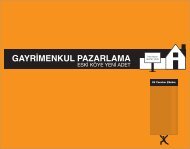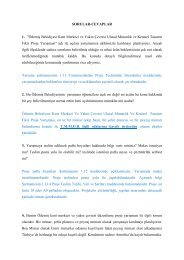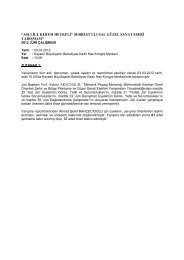VitrA ÃaÄdaÅ Mimarlık Dizisi - Arkitera
VitrA ÃaÄdaÅ Mimarlık Dizisi - Arkitera
VitrA ÃaÄdaÅ Mimarlık Dizisi - Arkitera
Create successful ePaper yourself
Turn your PDF publications into a flip-book with our unique Google optimized e-Paper software.
appraisal<br />
Evolution of Tourism Industry*<br />
Tourism, subject to this book is a young sector. It has a history of 100 or 150 years in the<br />
world, regardless of independent travellers or adventurers such as Marco Polo and Evliya<br />
Çelebi. Looking at Turkey and Anatolia specifically, it is much younger. We can say that<br />
the emergence of the sector coincides with the use of steam engines in ships and trains.<br />
Tourism, as we know it today, i.e. with its transportation, transfer, front and back services<br />
and service structures, has probably a history of sixty to seventy years in the world and<br />
does not go, beyond 30 to 35 years in our country.<br />
The investors’ profile in the business can be considered in this context. The profile of tourism<br />
investors in Turkey, are mainly related to the dynamics of thirty years ago. First of all<br />
we can talk about the construction industry which holds capital, labour and know-how in<br />
the hand. This industry operated abroad, especially in countries such as Iraq, Libya, Russia<br />
and had a remarkable ability to produce. They sought out investment opportunities<br />
within the country and embarked on the promotion of tourism investment in the Özal<br />
period. This being the case, the construction industry mentioned earlier, and the people<br />
and institutions in the textile sector who have realized surplus-value on the other hand,<br />
started to enter the tourism business as a new business area. These investors were not<br />
adequately equipped in terms of subtleties and details of tourism in the 80s. The tour<br />
operators, who increasingly found Turkey popular, couldn’t guide the investors. So, naturally<br />
the architectural needs were not set forth in a healthy way. Facilities were partly<br />
imitated or some of the appreciated concepts were rebuilt.<br />
We have developed tourist facilities according to the origin of the tourists. According to<br />
this approach, that I call “colonial tourism”, i.e. German Tourists would come to Turkey<br />
with a German airplane, would be welcomed in their own language and brought to the<br />
facilities and here again, they would have a holiday with people from their own country.<br />
Facilities were organized by their understanding of music, food, entertainment, and recreation,<br />
which as a result led to an architecture detailed and built according to the tourist’s<br />
familiar way of life. In such a tourism business environment, it was inevitable that the<br />
architecture would follow this approach. After some time we headed for an understanding<br />
of what we call a “themed” hotel, which was thoroughly exaggerated. Particularly<br />
architects who are conscious of the local architecture, including local residents and representatives<br />
of the sector increasingly criticized this trend. However, surprisingly, the polls<br />
done by tour operators revealed that the tourists staying in these facilities were very<br />
satisfied and happy with the situation.<br />
Towards the end of the 90s, understanding of mass tourism all over the world started to<br />
change step by step, various travel and holiday options other than sea-sun-sand travels<br />
in the summer and skiing in the winter, began to emerge. For instance, the relative weight<br />
of tendencies such as; mountain climbing, forest trekking, rafting or exploring a city,<br />
or to experience the life, culture of entertainment and eating with the local community,<br />
showed a continuous increase. The process of solving the structure of a uniform mass<br />
tourism, especially towards the end of the 90s particularly emphasized the importance<br />
of the local. People who came to Cappadocia wanted to meet specific things which did<br />
not belong to their own country. The fashionable and common saying; “think global,<br />
act local”, also reflected as an understanding in the architecture of tourism. Eclectic and<br />
42



